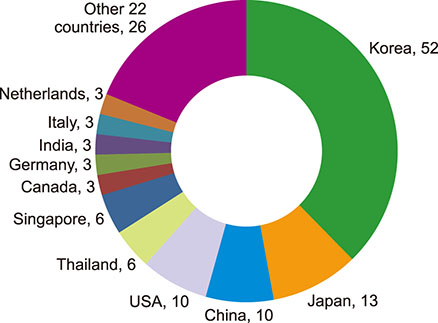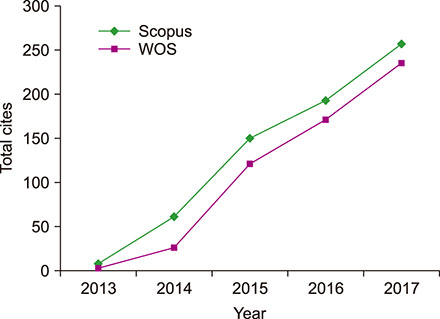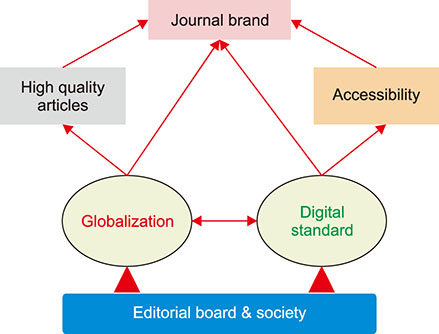Blood Res.
2018 Jun;53(2):95-100. 10.5045/br.2018.53.2.95.
How much progress has Blood Research made since the change of the journal title in 2013
- Affiliations
-
- 1Department of Parasitology and Institute of Medical Education, College of Medicine, Hallym University, Chuncheon, Korea.
- KMID: 2451022
- DOI: http://doi.org/10.5045/br.2018.53.2.95
Abstract
- BACKGROUND
Blood Research (formerly) was renamed 5 years ago. It aimed to identify the progress of the renamed journal at the international level based on journal metrics.
METHODS
Journal metrics, including total cites, impact factor, and Hirsch index were calculated or found from Scopus, SCimago Journal & Country Rank, and Web of Science on March 27, 2018.
RESULTS
The number of citable articles from 2013 to 2017 was 196, and that of non-citable articles was 157. The authors belonged to 25 countries. The editorial board members were from 33 countries. Total cites in Scimago Journal & Country Rank and Web of Science Core Collection in 2017 was 257 and 235, respectively. The cites per two years from Scimago Journal & Country Rank and the calculated impact factor from Web of Science Core Collection in 2016 were 1.353 and 1.382, respectively. The number of citing authors' countries in Web of Science Core Collection was 61. The number of citing journals in Web of Science Core Collection was 422. In 2016, the Hirsch index was 12 for Scimago Journal & Country Rank, and that in Web of Science Core Collection was 10.
CONCLUSION
Since the title change, Blood Research has progressed rapidly on the international scene in terms of journal metrics. In particular, the results of total cites, impact factor, and Hirsch index were outstanding. This will enable its promotion as a high branded journal in the hematology category.
MeSH Terms
Figure
Cited by 2 articles
-
Recent advances of medical journals in Korea and and further development strategies: Is it possible for them to publish Nobel Prize-winning research?
Sun Huh
J Korean Med Assoc. 2018;61(9):524-531. doi: 10.5124/jkma.2018.61.9.524.Promotion to Top-Tier Journal and Development Strategy of the
Annals of Laboratory Medicine for Strengthening its Leadership in the Medical Laboratory Technology Category: A Bibliometric Study
Sun Huh
Ann Lab Med. 2022;42(3):321-330. doi: 10.3343/alm.2022.42.3.321.
Reference
-
1. Clarivate Analytics. The Thomson Reuter's impact factor. London, UK: Clarivate Analytics;2017. Accessed March 27, 2018. http://wokinfo.com/essays/impact-factor/.2. Jeong GH, Huh S. The great rise of Intestinal Research as an international journal 3 years after its language change to English as evidenced by journal metrics. Intest Res. 2017; 15:1–4.
Article3. Hirsch JE. An index to quantify an individual's scientific research output. Proc Natl Acad Sci U S A. 2005; 102:16569–16572.
Article4. Huh S. The rapid internationalization of Annals of Pediatric Endocrinology & Metabolism as evidenced by journal metrics. Ann Pediatr Endocrinol Metab. 2017; 22:77–81.
Article5. Huh S. Clinical and Experimental Vaccine Research's promotion to internationally competitive journal evidenced by journal metrics. Clin Exp Vaccine Res. 2017; 6:67–71.
Article6. Huh S. How much is Journal of Educational Evaluation for Health Professions promoted based on journal metrics? J Educ Eval Health Prof. 2015; 12:57.
Article7. Huh S. How journal metrics illustrate the transformation of archives of plastic surgery into an international journal. Arch Plast Surg. 2014; 41:617–619.
Article8. Huh S. Promotion of the Journal of Exercise Rehabilitation to the international level based on journal metrics. J Exerc Rehabil. 2016; 12:510–514.
Article9. Huh S. Clinics in Orthopedic Surgery's evolution into an international journal based on journal metrics. Clin Orthop Surg. 2016; 8:127–132.
Article10. Huh S. Journal Article Tag Suite 1.0: National Information Standards Organization standard of journal extensible markup language. Sci Ed. 2014; 1:99–104.
Article11. Jeong GH, Huh S. Status of digital standards in Korean medical journals in 2016. Sci Ed. 2016; 3:100–104.
Article12. Jeong GH, Huh S. Increase in frequency of citation by SCIE journals of non-Medline journals after listing in an open access full-text database. Sci Ed. 2014; 1:24–26.
Article13. Lammey R. How to apply CrossMark and FundRef via CrossRef extensible markup language. Sci Ed. 2014; 1:84–90.
Article14. Lammey R. CrossRef tools for small publishers. Sci Ed. 2015; 2:79–85.
Article15. Lammey R. CrossRef text and data mining services. Sci Ed. 2015; 2:22–27.
Article16. Huh S. How Asian publishers can compete with publishers in Europe and North America. Sci Ed. 2018; 5:73–75.
Article17. Huh S. Establishment of an open data policy for Journal of Educational Evaluation for Health Professions, appreciation for invited reviewers, and acknowledgement of volunteers who made audio recordings. J Educ Eval Health Prof. 2017; 14:37.18. Im J. Applying open researchers and contributors ID in scholarly journals. Sci Ed. 2015; 2:28–31.
Article19. Bi X. Quality open access publishing and registration to directory of open access journals. Sci Ed. 2017; 4:3–11.
Article20. Chi Y. Scientific publishing in the Asian century: an international perspective. Sci Ed. 2016; 3:112–115.
Article
- Full Text Links
- Actions
-
Cited
- CITED
-
- Close
- Share
- Similar articles
-
- Erratum: Incorrect Title of the Author. Opioid Pharmacotherapy for Chronic Noncancer Pain: The American Experience
- The association of perfluoroalkyl substances (PFAS) exposure and kidney function in Korean adolescents using data from Korean National Environmental Health Survey (KoNEHS) cycle 4 (2018–2020): a cross-sectional study
- Association between coronavirus disease 2019-related workplace interventions and prevalence of depression and anxiety
- The Association Between Lung Function and Type 2 Diabetes in Koreans
- The effect of blood cadmium levels on hypertension in male firefighters in a metropolitan city









